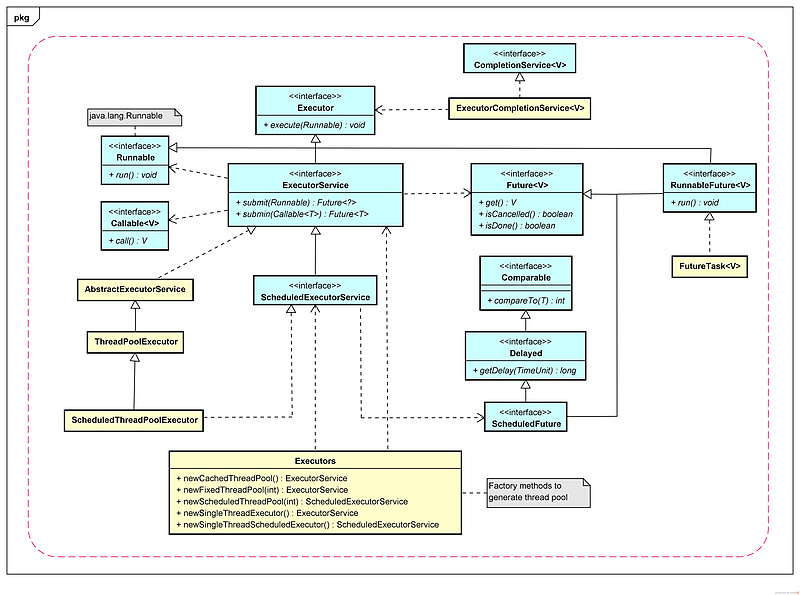引言
Executor框架是指JDK 1.5中引入的一系列并发库中与Executor相关的功能类,包括Executor、Executors、ExecutorService、Future、Callable等。
为什么要引入Executor框架?
如果使用new Thread(...).start()的方法处理多线程,有如下缺点:
- 开销大。对于JVM来说,每次新建线程和销毁线程都会有很大的开销。
- 线程缺乏管理。没有一个池来限制线程的数量,如果并发量很高,会创建很多的线程,而且线程之间可能会有相互竞争,这将会过多得占用系统资源,增加系统资源的消耗量。而且线程数量超过系统负荷,容易导致系统不稳定。
使用线程池的方式,有如下优点:
- 复用线程。通过复用创建的了的线程,减少了线程的创建、消亡的开销。
- 有效控制并发线程数。
- 提供了更简单灵活的线程管理。可以提供定时执行、定期执行、单线程、可变线程数等多种线程使用功能。
Executor框架的UML图

下面开始分析一下Executor框架中几个比较重要的接口和类。
Callable
Callable 位于java.util.concurrent包下,它是一个接口,只声明了一个叫做call()的方法。1
2
3
4
5
6
7
8
9
10
public interface Callable<V> {
/**
* Computes a result, or throws an exception if unable to do so.
*
* @return computed result
* @throws Exception if unable to compute a result
*/
V call() throws Exception;
}
Callable 接口类似于Runnable,两者都是为了其实例可以被另一个线程去执行而设计的。和 Runnable 接口中的run()方法类似,Callable 提供一个call()方法作为线程的执行体。但是call()方法比run()方法更加强大,这要体现在:
1)call 方法可以有返回值。返回值的类型即是 Callable 接口传递进来的V类型。
2)call 方法可以声明抛出异常。
Future
Future 接口位于java.util.concurrent包下,是Java 1.5中引入的接口.
Future主要用来对具体的Runnable或者Callable任务的执行结果进行取消、查询是否完成、获取结果。必要时可以通过get()方法获取执行结果,get()方法会阻塞直到任务返回结果。1
2
3
4
5
6
7
8
9
10
11
12
13
14public interface Future<V> {
boolean cancel(boolean mayInterruptIfRunning);
boolean isCancelled();
boolean isDone();
V get() throws InterruptedException, ExecutionException;
V get(long timeout, TimeUnit unit)
throws InterruptedException, ExecutionException, TimeoutException;
}
当你提交一个Callable对象给线程池时,将得到一个Future对象,并且它和你传入的Callable示例有相同泛型。
Future 接口中的5个方法:
- cancel方法:用来取消任务,如果取消任务成功则返回true,如果取消任务失败则返回false。
参数mayInterruptIfRunning表示是否允许取消正在执行却没有执行完毕的任务,如果设置true,则表示可以取消正在执行过程中的任务。
如果任务已经完成,则无论mayInterruptIfRunning为true还是false,此方法肯定返回false,即如果取消已经完成的任务会返回false;
如果任务正在执行,若mayInterruptIfRunning设置为true,则返回true,若mayInterruptIfRunning设置为false,则返回false;
如果任务还没有执行,则无论mayInterruptIfRunning为true还是false,肯定返回true。 - isCancelled方法:表示任务是否被取消成功,如果在任务正常完成前被取消成功,则返回 true。
- isDone方法:表示任务是否已经完成,若任务完成,则返回true;
- get()方法:用来获取执行结果,这个方法会产生阻塞,会一直等到任务执行完毕才返回;
- get(long timeout, TimeUnit unit):用来获取执行结果,如果在指定时间内,还没获取到结果,会抛出
TimeoutException异常。
也就是说Future提供了三种功能:
1)判断任务是否完成。
2)能够中断任务。
3)能够获取任务执行结果。
Executor
Executor是一个接口,它将任务的提交与任务的执行分离开来,定义了一个接收Runnable对象的方法execute。Executor是Executor框架中最基础的一个接口,类似于集合中的Collection接口。1
2
3
4
5
6
7
8
9
10
11
12
13
14public interface Executor {
/**
* Executes the given command at some time in the future. The command
* may execute in a new thread, in a pooled thread, or in the calling
* thread, at the discretion of the {@code Executor} implementation.
*
* @param command the runnable task
* @throws RejectedExecutionException if this task cannot be
* accepted for execution
* @throws NullPointerException if command is null
*/
void execute(Runnable command);
}
ExecutorService
ExecutorService继承了Executor,是一个比Executor使用更广泛的子类接口。定义了终止任务、提交任务、跟踪任务返回结果等方法。
一个ExecutorService是可以关闭的,关闭之后它将不能再接收任何任务。对于不再使用的ExecutorService,应该将其关闭以释放资源。
ExecutorService方法介绍
1 | package java.util.concurrent; |
shutdown() 和 shutdownNow() 是用来关闭连接池的两个方法,而且这两个方法都是在当前线程立即返回,不会阻塞至线程池中的方法执行结束。调用这两个方法之后,连接池将不能再接受任务。
下面给写几个示例来加深ExecutorService的方法的理解。
先写两个任务类:ShortTask和LongTask,这两个类都继承了Runnable接口,ShortTask的run()方法执行很快,LongTask的run()方法执行时间为10s。1
2
3
4
5
6
7
8
9
10
11
12
13
14public class LongTask implements Runnable {
public void run() {
try {
TimeUnit.SECONDS.sleep(10L);
} catch (InterruptedException e) {
e.printStackTrace();
}
System.out.println("complete a long task");
}
}
1 | public class ShortTask implements Runnable { |
测试shutdown()方法
1 |
|
控制台输出的结果:1
2
3
4
5
6
7
8
9
10
11
12
13
14
15complete a short task...
线程池是否已经关闭:true
complete a short task...
complete a short task...
线程池中还有任务在执行,当前时间:19:53:08
线程池中还有任务在执行,当前时间:19:53:09
线程池中还有任务在执行,当前时间:19:53:10
线程池中还有任务在执行,当前时间:19:53:11
线程池中还有任务在执行,当前时间:19:53:12
线程池中还有任务在执行,当前时间:19:53:13
线程池中还有任务在执行,当前时间:19:53:14
线程池中还有任务在执行,当前时间:19:53:15
线程池中还有任务在执行,当前时间:19:53:16
complete a long task
线程池中已经没有在执行的任务,线程池已完全关闭!
测试shutdownNow()方法
1 |
|
控制台输出:1
2
3
4
5
6
7
8
9
10
11
12
13
14
15
16
17
18
19
20
21
22
23
24
25
26
27
28
29
30
31
32
33
34
35
36java.lang.InterruptedException: sleep interrupted
at java.lang.Thread.sleep(Native Method)
at java.lang.Thread.sleep(Thread.java:340)
at java.util.concurrent.TimeUnit.sleep(TimeUnit.java:386)
at com.lzumetal.multithread.threadpooltest.LongTask.run(LongTask.java:11)
at java.util.concurrent.Executors$RunnableAdapter.call(Executors.java:511)
at java.util.concurrent.FutureTask.run(FutureTask.java:266)
还没有执行的任务数:2
at java.util.concurrent.ThreadPoolExecutor.runWorker(ThreadPoolExecutor.java:1149)
线程池是否已经关闭:true
at java.util.concurrent.ThreadPoolExecutor$Worker.run(ThreadPoolExecutor.java:624)
complete a long task
at java.lang.Thread.run(Thread.java:748)
complete a long task
java.lang.InterruptedException: sleep interrupted
complete a long task
at java.lang.Thread.sleep(Native Method)
at java.lang.Thread.sleep(Thread.java:340)
at java.util.concurrent.TimeUnit.sleep(TimeUnit.java:386)
at com.lzumetal.multithread.threadpooltest.LongTask.run(LongTask.java:11)
at java.util.concurrent.Executors$RunnableAdapter.call(Executors.java:511)
at java.util.concurrent.FutureTask.run(FutureTask.java:266)
at java.util.concurrent.ThreadPoolExecutor.runWorker(ThreadPoolExecutor.java:1149)
at java.util.concurrent.ThreadPoolExecutor$Worker.run(ThreadPoolExecutor.java:624)
at java.lang.Thread.run(Thread.java:748)
java.lang.InterruptedException: sleep interrupted
at java.lang.Thread.sleep(Native Method)
at java.lang.Thread.sleep(Thread.java:340)
at java.util.concurrent.TimeUnit.sleep(TimeUnit.java:386)
at com.lzumetal.multithread.threadpooltest.LongTask.run(LongTask.java:11)
at java.util.concurrent.Executors$RunnableAdapter.call(Executors.java:511)
at java.util.concurrent.FutureTask.run(FutureTask.java:266)
at java.util.concurrent.ThreadPoolExecutor.runWorker(ThreadPoolExecutor.java:1149)
at java.util.concurrent.ThreadPoolExecutor$Worker.run(ThreadPoolExecutor.java:624)
at java.lang.Thread.run(Thread.java:748)
线程池中已经没有在执行的任务,线程池已完全关闭!
从上面我们看到当调用了试图shutdownNow()后,那三个执行的任务都被interrupt了。而且awaitTermination(long timeout, TimeUnit unit)方法返回的是true。
测试submit(Callable<T> task)方法
Callabel任务类:1
2
3
4
5
6
7
8
9
10
11
12
13
14
15package com.lzumetal.multithread.threadpooltest;
import java.util.concurrent.Callable;
import java.util.concurrent.TimeUnit;
public class CallableTask implements Callable<String> {
public String call() throws Exception {
TimeUnit.SECONDS.sleep(5L);
return "success";
}
}
测试:1
2
3
4
5
6
7
8
9
10
11
12
13
14
15
16
17
18
19
20
21
22
23
public void testSubmitCallable() {
ExecutorService threadpool = null;
try {
threadpool = Executors.newFixedThreadPool(3);
final SimpleDateFormat sdf = new SimpleDateFormat("HH:mm:ss");
System.out.println("提交一个callable任务到线程池,现在时间是:" + sdf.format(new Date()));
Future<String> future = threadpool.submit(new CallableTask());
System.out.println("获取callable任务的结果:" + future.get() + ",现在时间是:" + sdf.format(new Date()));
} catch (InterruptedException | ExecutionException e) {
e.printStackTrace();
} finally {
if (threadpool != null) {
threadpool.shutdown();
}
}
}
控制台输出:1
2提交一个callable任务到线程池,现在时间是:20:25:27
获取callable任务的结果:success,现在时间是:20:25:32